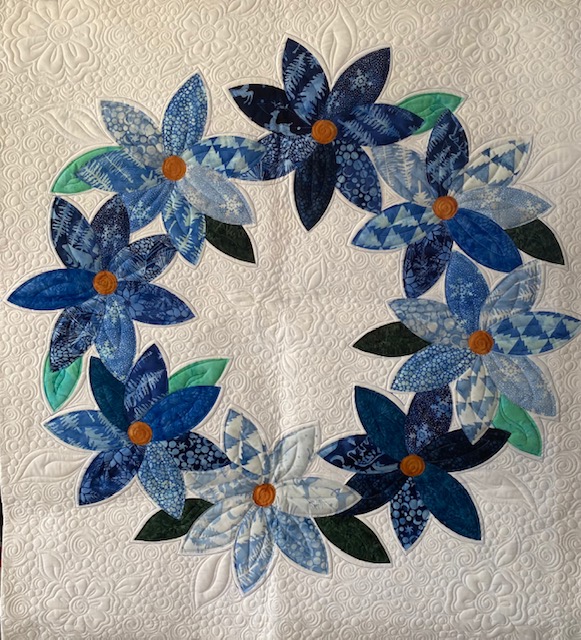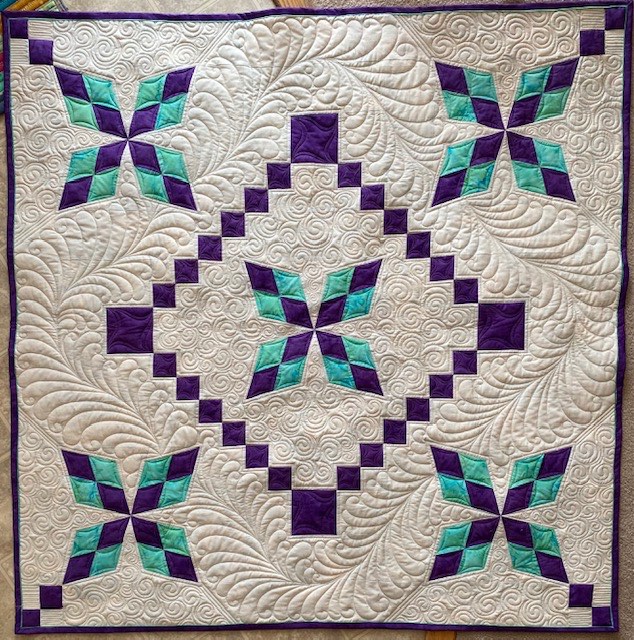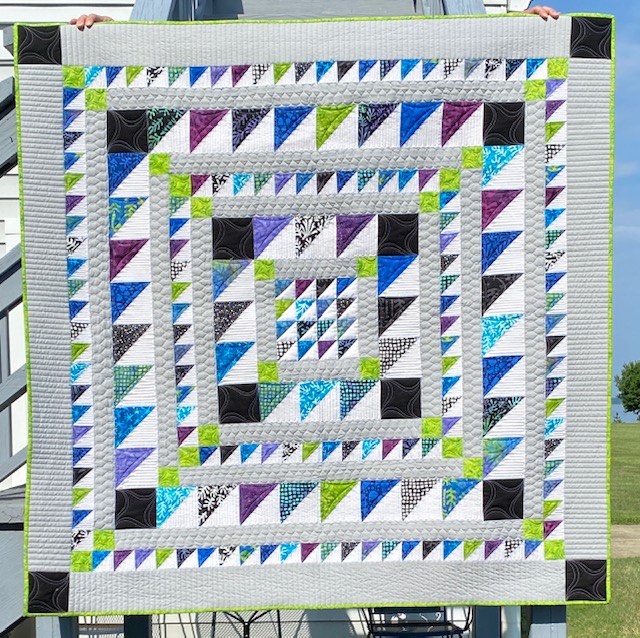Quilting her own early quilts with an eye toward helping the family budget, award winning quilter and designer Jane Hauprich loved the process so much she started quilting for others, launching her own successful longarm quilting business. Her favorite projects are those where she has free rein to create a custom design. Jane is passionate about sharing free motion quilting skills and offers tutorials for all skill levels on her You Tube channel along with in-person and online workshops.

What inspired you to start quilting?
I first began piecing quilts when I took a class at a local church. I was a young mom with three children. Because of that, my piecing of quilts was sporadic, but I soon realized as a single mom that I couldn’t afford to send my quilt tops out to be quilted, so I would need to do them myself. I started with stitch in the ditch type quilting, and eventually worked my way up to teaching myself free motion quilting on my domestic machine.
Fast forward several years, and I was at a quilt show and kept on gravitating to the Handi Quilter booth and the Sweet Sixteen Stationary machine. I must have gone back to the booth no less than five times. Needless to say, I walked out of that show owning a stationary longarm.
Fast forward about three more years, and I took a class at a local quilt shop about starting your own longarm business. I was unhappy with my career at that time (I was a phlebotomist – so I say I traded one needle for another needle…lol!!) so I decided I would start my own business. I sold my Sweet Sixteen and purchased a Handi Quilter Avanté. While I loved quilting on a stationary machine, it was really when I started quilting for others that my passion for free motion quilting took off!! I am to the point now, that I can’t imagine my life without a longarm in it.
As an Amazon Associate I earn from qualifying purchases. Read more about our affiliate linking policy.
I do have to tell you that when my first longarm was set up in my house, I was scared to death of it, and it took me two weeks to go in that room and make myself load some fabric and quilt!! LOL!!!

How has your creativity evolved over the years? What triggered the evolution to new media/kinds of work/ways of working? How did you get started quilting for others?
I think the more I free motion, the more I am willing to branch out and try new things. I can tell my earlier work, as it was much simpler. As time went on and the more quilting I did, I gravitated to quilting more densely.
I started with pieced quilts by myself and others, but my passion for free motion outweighed my passion for piecing, and I found myself looking at fabric and contemplating what type of design I could do to quilt the fabric. Ice dyed fabrics are wonderful for this. I also started to design my own whole cloths as a way to be able to quilt without having to piece. I will try to quilt with just about anything. I’ve done quilts with disassembled silk flowers, vintage linens, silk, organza and more!!!
Don’t get me wrong, I do enjoy piecing, but I just love free motion quilting that much more.
As far as quilting for others, a few months after I got my Handi Quilter Avanté, I had someone at a local quilt shop ask me if I would custom quilt her quilt. That was a scary step. It took me quite a while to get it done, but she ended up with a ribbon at the local county fair. That was the start of quilting for others. I’ve not looked back. I do mostly free motion custom quilting, but I can also do computerized edge to edge quilting.
What do you do differently? What is your signature that makes your work stand out as yours?
People say they can recognize my work, but I’m not sure why. I do love to quilt feathers, so in most of my quilts, you will find some kind of feathers, if possible!! I also tend to be heavy handed in my quilting. Free motion quilting really fuels my passion. I find when I am at the longarm working on a custom quilt that everything in life goes away and it takes me to another place. I find a lot of peace while I am quilting.
My other passion is to help others learn the free motion process, so I have a YouTube channel where I do try to share free motion tutorials, when possible.

How do you stay organized when working with multiple design ideas and processes?
I have a process I go through when designing the quilting for a custom quilt. After my first custom quilt took so long to complete, I realized I needed to come up with a plan.
The first thing I do is to hang the quilt on a clothesline in my quilt room. I leave it up while I am working on another quilt. This way the quilt becomes ingrained in my mind, and I find myself thinking about it at times other than when I am in the room. I’ve even been in the shower and think “aha, that’s what I need to do in that one section” …. LOL!!
I also take a picture of the quilt and doodle on it to get a feel for what might complement the quilt and I find out quickly what doesn’t work. I find that having a plan gives me permission to start quilting the quilt!!
Of course, there are some quilts where I just load it and wing it, but most often I have an idea of what I want to stitch on the quilt.
My favorite customer quilts are the ones where they hand me the quilt and tell me to “do your thing”. It’s like an artist with a blank slate, except that I have a quilt top to design around.

What advice would you give to sewists who want to begin quilting their own quilts? What do newbies need to get started?
My wish for all quilters hoping to quilt their own quilts is that they give themselves the grace needed to not be so critical of their work. We all were beginners at first, and I don’t like to see beginners comparing themselves to other quilters who are further along in their quilting journey. I would also tell them to relax and try to have fun. If you practice 10-15 minutes every day, you will notice a definite difference at the end of the week and even more after a month. Give yourself permission to try, to make mistakes and to make those mistakes into design choices.
My other suggestion would be to take classes. There are so many tutorials online and so many teachers that are offering virtual classes and on demand classes. Take advantage of their knowledge and experience.
As far as a machine, you will need a free motion foot on a domestic machine. It’s great to be able to drop your feed dogs, if possible, but it’s not the end of the world if you can’t. Longarm machines are great to try also. A fun way to try them is to find a local shop that rents their longarms out or go to a show and walk around and try all the different brands. I am biased though, as I am a Handi Quilter Ambassador (former Handi Quilter Educator) and love the Handi Quilter longarms.

What is the difference between quilting on a sit-down machine and a stand-up longarm?
On a stationary longarm and on domestic machines, you are pushing your fabric sandwich (which must be basted first) around through the throat space and on the table. With a domestic machine especially, you are very limited with your throat space.
With a stand up moveable longarm, you are loading the fabric and batting and then moving (driving) the machine over that fabric. I have a stationary longarm (Handi Quilter Capri) and a moveable longarm (Handi Quilter Amara).
As far as what works best….it is a personal preference as to whether you want to move the fabric or move the machine. The good news is that there is no right or wrong answer….it’s what works best for each person.

What do you do to develop your skills? How do you get better at what you do?
I like to doodle a lot which I believe helps me with my longarm skills. If I know how that design is going to draw out, then I can stitch it out, too. It helps to think of your needle as your pencil.
I think when you are quilting for others, it is also important to give yourself play time on your longarm. I have a closet full of quilt tops of mine that are just waiting to be quilted, and I give myself permission to do those in between customer quilts, when possible. Working on a blank piece of fabric or an ice dyed fabric really makes me work creatively, which I think helps me grow as a quilter.

What motivates you artistically?
Custom quilting and being creative motivates me. The passion and joy I find at my longarm is amazing. Having a custom project that you can have a vision for is very motivating. It’s always exciting to load the next quilt. The finishing of the quilt is rewarding, too. To know I did a good job is so fulfilling. Returning the quilt to my customer and to see the look on their face when they see the finished quilt for the first time is so much fun. I’ve had customers that were so thrilled with their completed quilt that they cried.

When making your own quilts, at what point in the piecing process do you start thinking about your quilting design?
I am probably thinking about the quilting while I am cutting the fabric and the entire time I am piecing. I am an Island Batik Ambassador and have had to do a lot more piecing in 2021 than I normally do, and I can say I am thinking of the quilting the entire way through the piecing process. If I have a pattern or have designed my own quilt, I will print that out and start doodling during the piecing process.

When it comes to creating, are you more of a planner or an improviser?
That made me laugh a little. I am more of a planner, but many times when I throw an ice dyed fabric on for myself, I tend to improvise and let the pattern guide me. Most of the time, I do feel better if I have a plan, though. My family will tell you that in my personal life, I am definitely a planner.
Do you have a dedicated space for creating? If so, what does it look like?
I actually have two spaces for creating as I don’t have one room large enough to fit it all in one. My longarms (movable and stationary) and one domestic machine (Janome 6600) are in what used to be a bedroom. It used to just hold my Handi Quilter Amara. However, when the pandemic hit, and I shifted to virtual teaching, I wanted all machines in one room so I could teach from all of them.
I do have an office/sewing space in another room. This is where I have my large cutting table, a straight stitch machine (HQ Stitch 510) and ironing table. This room also acts as an office for my home life and business.

What are the indispensable tools and materials in your studio? How do they improve your work?
Hmmmm……as far as piecing, my rotary cutter, my sewing machine and my design wall. As far as longarming, I would have to say all of the thread that I get to use, all the rulers I have and my longarm machines!!! Also, some good marking utensils are important.
Do you use a sketchbook or journal? How does that help your work develop?
I do have a sketchbook, but often, I am sketching or doodling on anything that is within my immediate reach. When I first started, I would doodle designs onto a piece of paper and if I was comfortable with that design, I would add it to a notebook to use for quilting ideas in the future.
I also use a drawing app on my computer so I can doodle right onto quilt pictures.

What plays in the background while you work? Silence? Music, audiobooks, podcasts, movies? If so, what kind?
Most of the time I quilt in silence. I sometimes listen to an audiobook. I find that if I have a large custom job, listening to an audiobook keeps me moving creatively while allowing my brain to think about the book. It helps to keep me focused.
A couple of years ago, my kids bought me a TV for my sewing studio. I thought it would be great for background noise. Needless to say I had to move it out of there, as it was so distracting. I would find myself watching the TV vs. working on the quilt.
Do you think that creativity comes naturally to people, or do you think creativity is a skill that people can learn?
I think anyone can be creative if they allow themselves to. I do think it comes more naturally for some people. With that being said, I think every creative person has an area where their passion is directed. I am always willing to learn new things and techniques.

How do you get unstuck creatively?
That can be tough sometimes. If I am feeling stuck on the creative side, I tend to either step away for a bit and do something else or quilt some quilts that I can do edge to edge free motion or edge to edge with my ProStitcher, which is a computerized program. Usually, this break helps me.
I do a lot of custom quilts, and I find that if I put a computerized edge to edge quilt on in between, it gives my body a chance to take a break from custom work and it also gives my brain a chance to relax.
Tell us about your website. What do you hope people will gain by visiting?
I hope that my website is inspiring. My website started as a blog several years ago. I do try to do one or two blog posts a month, so there is quite a bit of content there. I added products to my website as I developed them. My main goal is for people to love free motion, so I do try to develop products that will help quilters learn free motion. Some of the items I have developed are free motion workbooks, free motion practice panels, and my own line of longarm rulers. My mind is always trying to think of ways to help free motion quilters.
You can sign up on the home page to receive an email when a new blog post is up. This way you’ll hear any news on classes and products. I promise I don’t post a lot, so you won’t be inundated with emails. 😊

Do you lecture or teach workshops? How can students/organizers get in touch with you to schedule an event?
I have a passion to help others learn the free motion process, so I have a YouTube channel where I do try to share free motion tutorials when possible.
I have been speaking and teaching for many years, including at multiple quilt shows. Currently I speak and teach virtually and have had many successful classes. For guilds or groups, I can offer lectures and one day workshops. For individuals, I typically run my classes over several weeks. We meet once a week via zoom (which I record). We do this for 4-5 weeks. Once each week’s class is done, I post the zoom recording to our private Facebook page, where students have access to it for three months. The private Facebook page has been a great way of interacting with everyone and seeing everyone’s progress in class. My students and I have both enjoyed this way of teaching and learning. I’ve had people from all over the world in these classes!!
I can be contacted at the following:
Website: https://stitchbystitchcustomquilting.com/
Email: stitchbystitchcustomquilting@gmail.com
Facebook: https://www.facebook.com/JanesStitchByStitch
Instagram: @janestitchbystitch
YouTube: https://www.youtube.com/c/JaneHauprich
Etsy: https://www.etsy.com/shop/JaneStitchByStitch
Interview posted November 2021
Browse through more inspiring machine quilting interviews and projects on Create Whimsy.
